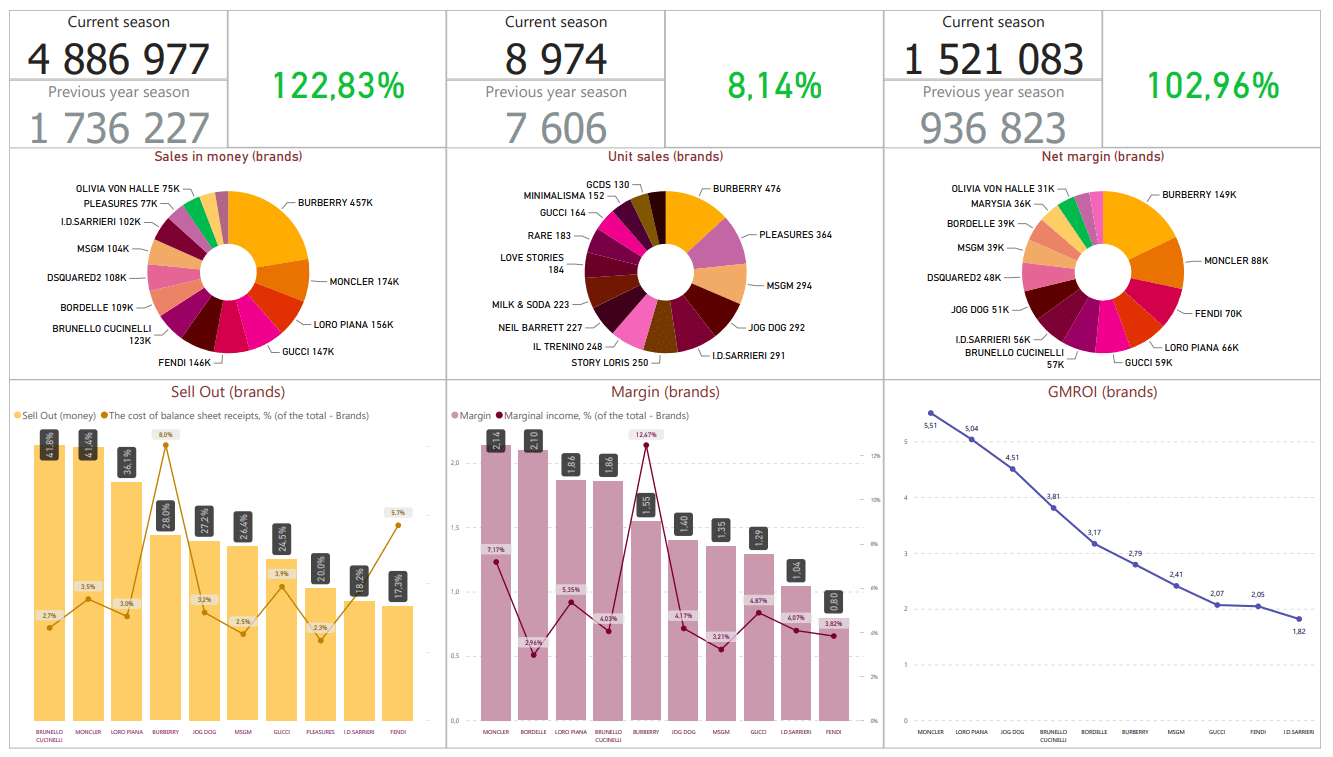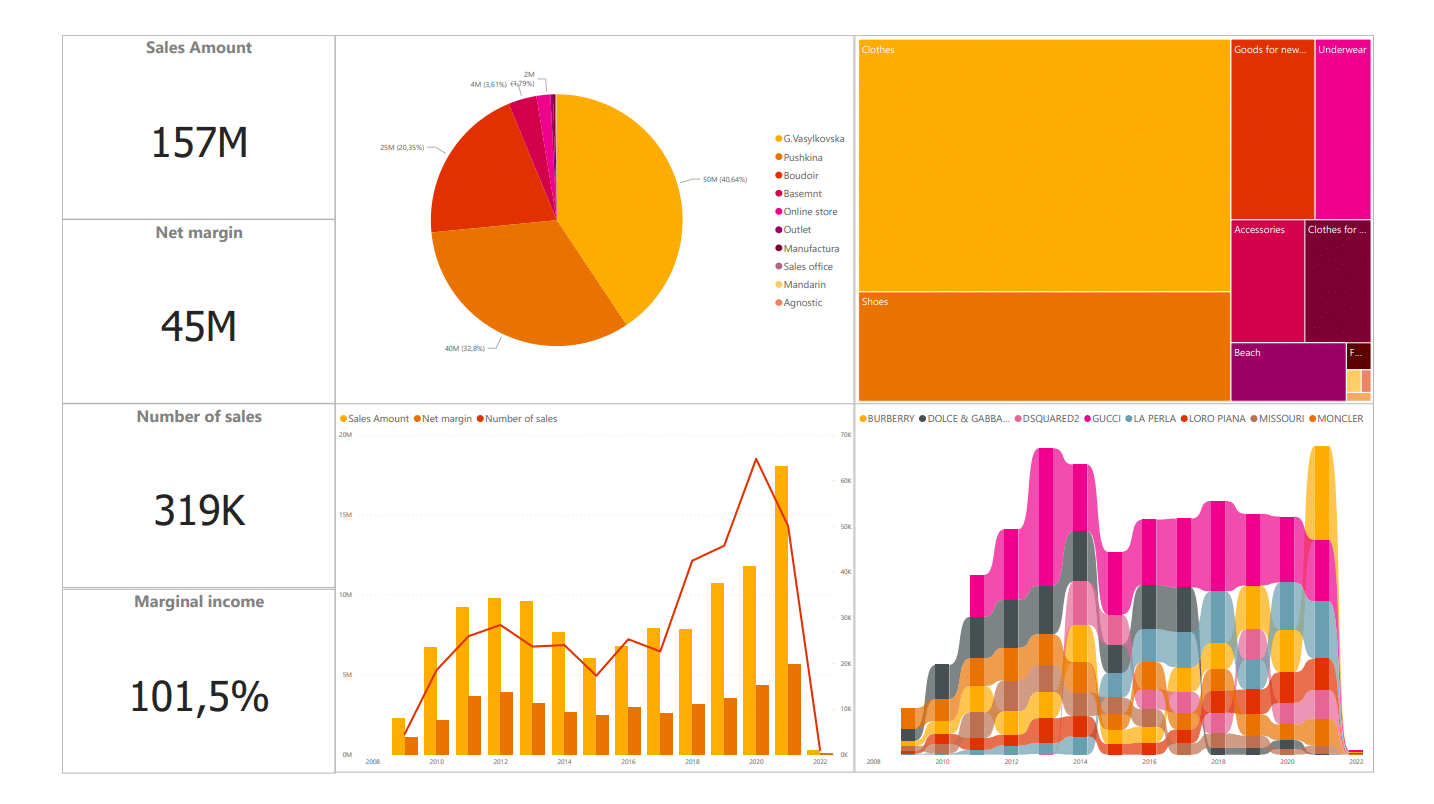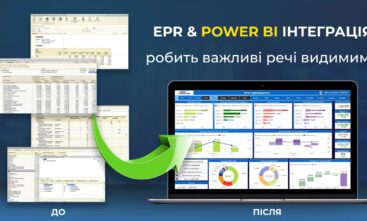
Нашим клієнтом став Helen Marlen Group — це лідер українського fashion retail-ринку, який виступає представником 190 брендів одягу, взуття, аксесуарів та інших сезонних товарів для роздрібних споживачів, що отримали всесвітнє визнання. З них 30 марок представлені у магазинах Helen Marlen Group ексклюзивно.
Керівництво цієї компанії дуже прогресивне: керівники не лише постійно стежать за модними течіями у сферах fashion, але й жваво цікавляться культурою та мистецтвом, постійно підтримуючи активних діячів та беручи участь у облагородженні пам’яток Києва. Якщо ви пам’ятаєте, 2005-го компанією в серці Києва було створено shopping-зону в рамках масштабного проєкту Passage Luxury Destination.
Сьогодні поділимося кейсом про запровадження Power BI у сферу роздрібної торгівлі. Його незвичайність у тому, що ми почали роботу на чужій платформі. Але про все по порядку.
Навіщо потрібна аналітика
retail-компанії
Сильні та слабкі сторони бізнесу
Порівняння сезонних показників
Найбільш затребувані колекції
Найкращі співробітники
Щоб мати можливість інтенсивно розвивати бізнес, потрібно бути відкритим новим знанням та постійно впроваджувати передові технології. І нам пощастило, що ми познайомилися із власниками та топ-менеджерами компанії. Особливо щільно ми попрацювали з Сергієм Тупкалом — фінансовим директором Helen Marlen Group — дуже прогресивним керівником, який розуміє, що для покращення фінансового результату та прискорення досягнення цілей бізнесу необхідно бачити чіткі та наочні дані, які легко перевірити.
Питання Helen Marlen Group залишаються актуальними для будь-якого магазину, який торгує колекціями товарів у ТРЦ від Ямалу до Нью-Йорка. Їм важливо постійно розширювати цільову аудиторію, яка стежить за модними течіями. Тому ми підготували кейс із інструментами, які допомагають їх вирішувати.
Мета впровадження Power BI у бізнес роздрібного продажу
- Усунути збої у роботі програм аналітики.
- Доопрацювати поточну надбудову з розвантаження програми обліку.
- Виконати низку планових робіт із завантаження звітів у дашбордах.
- Позбавити фінансових аналітиків від необхідності постійно перевіряти ще раз дані.
Які складнощі були у компанії
Програма була, але не працювала як слід
Компанія вже мала програму з вилучення даних для звітності. Сергій давно звернув увагу на Power BI та на момент нашого знайомства вже мав досвід роботи з ним. Але у самій програмі періодично відбувалися збої. Часто проблема виникала при зміні сезону: раптом переставали сходитися дані щодо надходження товарів.
Співробітнику впоратися з BI не вдалося
Якось виникла ідея доручити проєкт активному співробітнику всередині команди, але вона не прижилася — у спеціаліста не вистачило компетенцій. Він працював виключно в конструкторі з обмеженими функціями, і не мав глибоких знань та досвіду роботи з базами даних. А без них проєкт не міг довести до потрібних результатів.
Аутсорс очікування не виправдав
Робота підрядниками велася, але повільно, і кожне нове завдання виконувалося з великою кількістю погоджень та доопрацювань. Аналітики змушені були займатися регулярними звірками та пошуком помилок.
«Підрядники виконували завдання повільно. Часто виникали збої, дані не сходилися. Доводилося все звіряти. Користуватись отриманими результатами було складно. Система, звичайно, працює, але не так, як ми очікували. Плюс мені постійно доводилося занурюватись у цей проєкт. Бувало не просто ставив технічні завдання, а підключався і як тестувальник, як постановник завдань, і як менеджер проєкту. А це тимчасові та ресурсні витрати. При цьому я маю чимало інших завдань», — згадує Сергій Тупкало.
Нам запропонували підтримувати платформу
Коли ми, Cobit Solutions, прийшли зі своєю пропозицією, ми запитали, чи згодні ми будемо підтримувати платформу, зроблену попереднім підрядником. Спершу нас це злякало. Але ми взяли проєкт у роботу.
Розібралися в коді підрядника
Зрештою ми розібралися, що саме було не так. Підрядник зробив проміжну базу DWH для вивантаження даних 1С, додавши до неї додаткові фільтри, критерії і т. і. В результаті для вивантаження однієї таблиці з SQL код писався вручну. Він був погано структурований та займав до 5 сторінок. І якщо в цій проміжній таблиці виникала якась помилка, знайти її швидко і виправити було практично нереально.
Змінили технологію на робочу
Ми виправили це. Зараз у Helen Marlen Group працює старий механізм. Він вивантажує дані з 1С у проміжну базу, яку зробив попередній підрядник. І паралельно з цим додали новий набір сутностей 1С, які безпосередньо інтегруються в BI за допомогою конектора Cobit Solutions. Ця частина працює набагато швидше ніж перша. Також ми рознесли оновлення в системі для зменшення навантаження на 1С, виправивши налаштування попереднього підрядника.
Ми використовуємо конектор, що дозволяє підключатися безпосередньо до бази Microsoft SQL, в якій 1С зберігає свої дані, і дає можливість бачити всі об’єкти 1С без будь-яких фільтрацій. Поступово все, що було надбудовано, ми переробили і перевели на сучасну робочу технологію. І головне — у ній все легко відстежується: наскільки сходяться цифри, а якщо не сходяться, то чому.
Дашборд основних показників
Дані заповнені випадковими числами.
Важливо починати з основ
Сергій Тупкало так прокоментував процес впровадження технологій: «Основа — як дані будуть вилучатися з 1С і структурна модель даних — це дуже важливо. До цього потрібно поставитися уважно і один раз зробити правильно. Бо якщо вам якийсь підрядник збере її з помилками, то, швидше за все, вам доведеться потім все переробляти».

Чи можна обійтися без підтримки після впровадження Power BI
На етапі первинного знайомства з нашим продуктом та послугами у потенційних клієнтів часто виникають питання:
- чи зможуть вони працювати з Power BI самостійно;
- хто краще – фахівці чи підрядники;
- чи постійно доведеться користуватися підтримкою компанії Cobit Solution.
Тому на референсі з представниками компаній Хелен Марлен та UMG ми попросили Сергія Тупкало прокоментувати їх.
Співробітники до штату чи завдання на аутсорс
Сергій Тупкало: «Перша точка диференціації ґрунтується на тому, як саме ви хочете співпрацювати: бажаєте розвивати фахівців з Power BI усередині компанії або віддавати завдання на аутсорс. У кожному варіанті є свої плюси та мінуси».
- Для штату потрібні добрі спеціалісти. Потрібно вміти правильно їх використовувати, давати повне завантаження.
- Потрібно вміти грамотно поставити технічне завдання.
- Можлива плинність людей, через яку наступність не зберігається. Коли люди йдуть, частина інформації гине, частина губиться.
- Якщо ви готові використовувати систему Power BI у всіх бізнес-процесах, розвивати її з великою аналітикою, тоді, напевно, є сенс тримати фахівців у штаті.
- Фахівець повинен одразу зрозуміти, про що йдеться, оскільки у кожному бізнесі, у кожному напрямі є багато нюансів.
- Може знадобитися час для налаштування єдиного понятійного апарату.
- Намагатися переключити завдання на іншого фахівця і чекати, що він завтра зробить звіт, марно.
- Якщо ваша мета має певні межі: ви хочете зробити візуалізацію або отримати оперативну інформацію щодо деяких функціональних областей бізнесу, варто розглядати аутсорс.
Приклад зручної роботи
Розуміння завдань
Зараз я працюю з одним із розробників Cobit Solutions. Я одразу відчув у роботі з нею зовсім інший підхід. Вона миттєво нас розуміє і робить все набагато швидше, ніж попередні хлопці. Причому людина робить все практично відразу правильно.
Чітка візуалізація
Якщо людина не має почуття акуратності та перфекціонізму, то багато часу йде на правки: шрифт не той, графік невірний, дані не ті. Крім того, це все переробляється за гроші замовника.
Верифікація даних
Дуже важливо правильно робити верифікацію даних із самого початку. Тому що переробити архітектуру баз даних DWH під себе і пояснювати новим фахівцям, як це все працює, як прописані ці запити, як викачуються дані — дуже трудомістке заняття».
«Бажано не міняти партнерів і йти до кінця з одними й тими самими людьми. Тому що у них, як то кажуть, крива навченості досягає певного рівня. І далі, з кожним звітом, з кожною візуалізацією працювати з ними стає дедалі легше та зручніше», — Сергій Тупкало.
Дашборд динаміки продажів
Дані заповнені випадковими числами.

Як часто потрібна підтримка підрядників
Щоб відповісти на це питання, варто врахувати такі фактори:
- Чи знадобиться людина, яка перевірятиме, що дані збігаються між різними джерелами?
- Наскільки часто знадобиться перевірка — раз на місяць, чи це потрібно лише на етапі тестування?
- Чи зможе бізнес самостійно функціонувати без саппорту підрядників?
Коментує Дмитро Чашник, СЕО Cobit Solutions: Зазвичай перевірка потрібна на етапі тестування нового функціоналу. У цей момент ми звіряємо, що контрольні цифри та дані вибірково збігаються з 1С. Тобто після побудови бази спочатку йдуть звіряльні дашборди та їх перевірка. Потім, коли вже робимо функціональні дашборди, їх спочатку звіряє програміст, потім менеджер проєктів фінансової аналітики. Він дивиться дані або по 1С, або вибирає опорні (контрольні) цифри, запит яких ми робимо у клієнта з існуючої звітності.
Щодо підтримки Helen Marlen Group, то до неї входять:
- дрібні виправлення;
- оновлення програм;
- відновлення баз, якщо раптом вони за тайм-аут відпали;
- всілякі доступи;
- консультації, відповіді на запитання».
Чим закінчилася ця історія
Після того, як ми добре себе показали на підтримці та доопрацюванні старого технологічного рішення, ми з Helen Marlen Group розширили співпрацю та почали виконувати завдання для їхньої окремої мережі дитячих магазинів Baby Marlen:
- Здійснили інтеграцію до Power BI 3-х баз 1С.
- Реалізували на базі BI фінансову консолідацію та виділення внутрішньогрупових операцій. Між трьома базами були внутрішньогрупові продажі і необхідно було налаштувати аналітику та розрахунки на цій основі.
- Зробили дашборди з продажу, маржинальності та валового прибутку.
- Реалізували набір моніторингових панелей для мобільного, до яких звикли власники основного бренду (зроблені у форматі плиток).
Наразі для мережі Helen Marlen Group ми робимо нові дашборди. Останній дашборд, що ми зробили, — це розрахунок амортизації.
«Зараз у мене всі дані оновлюються щодня. Я періодично дивлюся, коли роблю свої звіти, чи все сходиться. І переконавшись, що все гаразд, живу собі спокійно далі», — каже Сергій Тупкало.
АЛЕ ГОЛОВНЕ В АНАЛІТИЦІ ЦЕ — ЗРОСТАННЯ ПРИБУТКУ
Наші дашборди дозволяють щодня контролювати доходи, собівартість, маржу, валовий прибуток та ще 47 інших показників бізнесу, не чекаючи щомісячного зведення звітності.
Регулярний контроль у результаті призводить до збільшення прибутку та зростання бізнесу.





